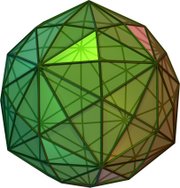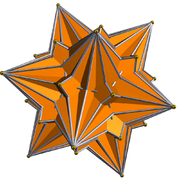Kleetope
In geometry and polyhedral combinatorics, the Kleetope of a polyhedron or higher-dimensional convex polytope P is another polyhedron or polytope PK formed by replacing each facet of P with a shallow pyramid.[1] Kleetopes are named after Victor Klee.[2]
Examples
The triakis tetrahedron is the Kleetope of a tetrahedron, the triakis octahedron is the Kleetope of an octahedron, and the triakis icosahedron is the Kleetope of an icosahedron. In each of these cases the Kleetope is formed by adding a triangular pyramid to each face of the original polyhedron.
 triakis tetrahedron Kleetope of tetrahedron. |
 tetrakis hexahedron Kleetope of cube. |
 triakis octahedron Kleetope of octahedron. |
 pentakis dodecahedron Kleetope of dodecahedron. |
 triakis icosahedron Kleetope of icosahedron. |
The tetrakis hexahedron is the Kleetope of the cube, formed by adding a square pyramid to each of its faces, and the pentakis dodecahedron is the Kleetope of the dodecahedron, formed by adding a pentagonal pyramid to each face of the dodecahedron.
 disdyakis dodecahedron Kleetope of rhombic dodecahedron. |
 disdyakis triacontahedron Kleetope of rhombic triacontahedron. |
 tripentakis icosidodecahedron Kleetope of icosidodecahedron. |
dihedra .
|
The base polyhedron of a Kleetope does not need to be a
The Goldner–Harary graph may be represented as the graph of vertices and edges of the Kleetope of the triangular bipyramid.
 small stellapentakis dodecahedron Kleetope of small stellated dodecahedron. |
 great stellapentakis dodecahedron Kleetope of great stellated dodecahedron. |
 great pentakis dodecahedron Kleetope of great dodecahedron. |
 great triakis icosahedron Kleetope of great icosahedron. |
Definitions
One method of forming the Kleetope of a polytope P is to place a new vertex outside P, near the centroid of each facet. If all of these new vertices are placed close enough to the corresponding centroids, then the only other vertices visible to them will be the vertices of the facets from which they are defined. In this case, the Kleetope of P is the convex hull of the union of the vertices of P and the set of new vertices.[3]
Alternatively, the Kleetope may be defined by duality and its dual operation, truncation: the Kleetope of P is the dual polyhedron of the truncation of the dual of P.
Properties and applications
If P has enough vertices relative to its dimension, then the Kleetope of P is dimensionally unambiguous: the graph formed by its edges and vertices is not the graph of a different polyhedron or polytope with a different dimension. More specifically, if the number of vertices of a d-dimensional polytope P is at least d2/2, then PK is dimensionally unambiguous.[4]
If every i-dimensional face of a d-dimensional polytope P is a simplex, and if i ≤ d − 2, then every (i + 1)-dimensional face of PK is also a simplex. In particular, the Kleetope of any three-dimensional polyhedron is a simplicial polyhedron, a polyhedron in which all facets are triangles.
Kleetopes may be used to generate polyhedra that do not have any
Kleetopes also have some extreme properties related to their vertex degrees: if each edge in a planar graph is incident to at least seven other edges, then there must exist a vertex of degree at most five all but one of whose neighbors have degree 20 or more, and the Kleetope of the Kleetope of the icosahedron provides an example in which the high-degree vertices have degree exactly 20.[7]
Notes
- ^ Grünbaum (1963, 1967).
- ^ Malkevitch, Joseph, People Making a Difference, American Mathematical Society.
- ^ Grünbaum (1967), p. 217.
- ^ Grünbaum (1963); Grünbaum (1967), p. 227.
- ^ Grünbaum (1967), p. 357; Goldner & Harary (1975).
- ^ Moon & Moser (1963).
- ^ Jendro'l & Madaras (2005).
References
- Jendro'l, Stanislav; Madaras, Tomáš (2005), "Note on an existence of small degree vertices with at most one big degree neighbour in planar graphs", Tatra Mountains Mathematical Publications, 30: 149–153, MR 2190255.
- Goldner, A.; Harary, F. (1975), "Note on a smallest nonhamiltonian maximal planar graph", Bull. Malaysian Math. Soc., 6 (1): 41–42. See also the same journal 6(2):33 (1975) and 8:104-106 (1977). Reference from listing of Harary's publications.
- S2CID 121075042.
- Grünbaum, Branko (1967), Convex Polytopes, Wiley Interscience.
- Moon, J. W.; Moser, L. (1963), "Simple paths on polyhedra", Pacific Journal of Mathematics, 13 (2): 629–631, MR 0154276.
- MR 1192384.
